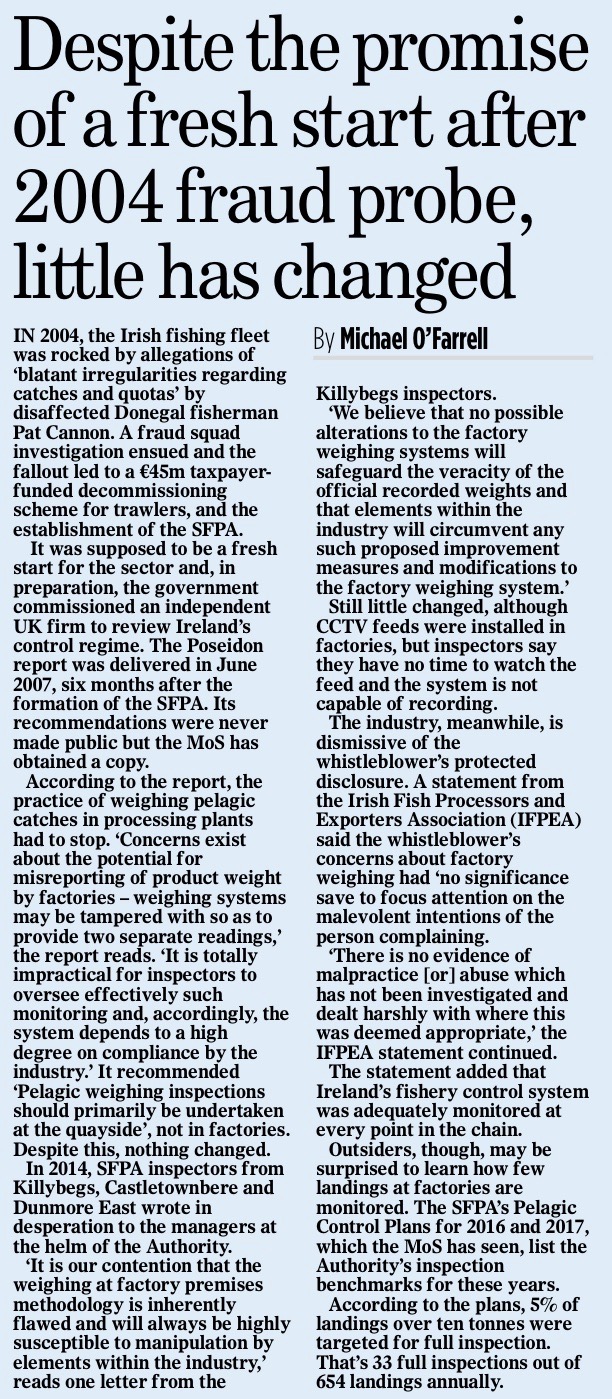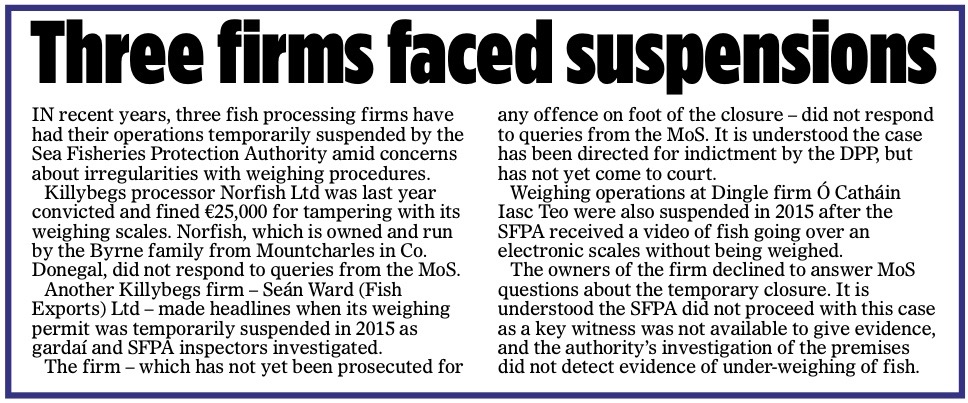By: Michael O’Farrell
Investigators Editor
IRELAND’S sea fishing watchdog sat on evidence that boats within our fleet were under-declaring the size of their fish holding tanks by up to 170% – for two and a half years, an Irish Mail on Sunday investigation can reveal.
According to a concerned whistleblower, who has made a protected disclosure to the MoS, this means that illegal catches, potentially worth millions of euro, could have been laundered through the system undetected.
Today’s revelations involving the Irish Refrigerated Sea Water (RSW) fleet also have serious implications for the sustainability of the fish stocks concerned, which are strictly controlled by quotas to ensure their survival. (PDF of this story as it appeared in the Irish Mail on Sunday is available for download here)
Just six months ago, the herring stock in the Celtic Sea – one of the main target species for Irish RSW trawlers – was stripped of its certified sustainability status by the Marine Stewardship Council because of plummeting fish levels.
Despite the decimation of these stocks, the Irish fishing industry – a powerful, politically-connected and well-resourced lobby group – has always denied that any overfishing takes place. But, in 2014, the Sea Fisheries Protection Authority (SFPA) commissioned a survey that appeared to suggest otherwise.
The survey – by independent Scottish marine engineering firm, OSDIMT Dundee – measured the capacity of the fish holding tanks on all 47 of the Irish RSW vessels.
These vessels – costing as much as €50m each – are among the largest in the Irish fleet and are capable of landing hundreds of tonnes of fish at a time. Together they land catches worth more than €100m annually.
Publicly filed accounts confirm that most of the owners of these trawlers are multi-millionaires who have benefitted substantially from State supports.
By law, the fish-carrying capacity of these ships must be declared on an approved ullage table – a certified document that must be carried on board each trawler showing precisely how big each tank is.
This document is vital because inspectors refer to it when calculating the results of dip tests intended to establish how full a fish tank is before a catch is landed.
The dip test is the first official check to ensure that a catch has been recorded properly in the ship’s log book before permission to land is granted.
Irregularities picked up by these dip tests can spark a full monitor, which involves inspectors being present as all fish on board are weighed. However, since inspectors were in many cases being presented with incorrect ullage tables, their dip tests will have failed to spot if there were more fish on board than listed in the ship’s log book.

The tank survey – which was commissioned on foot of intelligence received by the SFPA – confirmed just this problem. The approved ullage tables were, in many cases, dramatically misleading. There was, for example, one instance of a trawler with a single tank 170% larger than declared – amounting to an additional 98 cubic metres.
The entire volume of fish holding tanks on at least nine other ships was found to be between 5% and 35% larger than declared.
This means that for years the dip tests being carried out by SFPA inspectors are likely to have significantly underesti-mated the size of catches. According to the whistleblower’s disclosure, the SFPA could establish how much extra fish may have been laundered through the system, since historical dip test results are kept on file and could be recalculated with the correct tank sizes. Such an audit could also discover whether any false accounting and Revenue offences may have accompanied the landing of additional, undeclared fish.
But the Authority – which costs the Irish taxpayer €10m annually and is headed up by a trio of members earning close to €100,000 each – has made no move to do so.
Instead, it appears the tank survey results were quietly kept in-house for years – and not even distributed to the Authority’s own inspectors, who were allowed to continue using the incorrect measurements.

When repeatedly asked by the MoS why it allowed vessel owners to continue using incorrect tank tables for years before correcting the inaccuracy, the SFPA did not directly answer the question.
‘While the SFPA was keen to ensure accurate tables were available for its use in estimating onboard catches, the onus is on vessel operators to have accurate ullage tables for their vessels,’ said a statement from the Authority.
The SFPA added that dip tests of catches could now be trusted. ‘The SFPA’s initial estimate of fish onboard is unlikely to be an underestimate, as certified accurate ullage tables are now being used,’ the statement said.
The Authority did not answer questions about why it had never publicly revealed that significant discrepancies in tank capacities had been discovered.
The SFPA first received the first batch of survey results for 23 RSW vessels in March 2015. It then decided to extend its survey to include a further 24 RSW vessels – bringing the total number of vessels surveyed to 47.
As well as checking tank sizes, the survey addressed SFPA concerns that some vessels ‘may have been able to pump fish between their RSW tanks to avoid the accurate quantification of fish retained onboard’. The Authority was also suspicious that a number of vessels had the capacity to ‘pump fish off the vessel under the waterline to avoid the accurate quantification of fish retained on board’.
Evidence of such fish dumps was discovered in 2013 when a diving survey beneath trawler berths at Killybegs found 1,215 tonnes of discarded fish worth over €1m on the seabed.
The survey also identified vessels with internal hooks inside tanks capable of holding back fish to alter a dip test result.
In 2016 – over a year after the SFPA began receiving the first survey results – some of the concerns discovered were listed in confidential intelligence warnings and risk lists distributed to inspectors on the ground.
‘There is a significant difference between the old and the surveyed volumes,’ one such warning obtained by the MoS reads. The vessels on these risk lists were targeted for additional inspections, although at best this meant 10% of their landings were fully monitored. Then in August 2017, over two years after the first survey results were obtained, the SFPA issued its inspectors with the correct tank measurements of each vessel.
However, the Authority decided against a look-back audit which could use the correct tables to rectify historical inaccurate estimates to establish how much illegal fish may have been landed.
At the same time as the correct ullage tables were distributed to inspectors, the Authority wrote to each vessel owner to say it would not prosecute them for overfishing despite the discrepancies found.
‘Discrepancies which may have arisen between the official survey results and your current tables and which suggest any resultant underdeclarations during previous landings have not been progressed for DPP consideration but SFPA, at this time, reserve the right to consider such a course of action in the future,’ the letter to each trawler owner reads.
Meanwhile, the issue – and the apparent amnesty from prosecution afforded to trawler owners – was kept secret and never made public, until now.
Asked why no look-back audit was being conducted and why no prosecutions were considered, the SFPA said: ‘A “dip” might provide an indication of a potential risk of an under-declaration, but would not prove it. The SFPA’s “dip” is not to the standard of evidence required for court.’ This approach is likely to cause concern at EU level and could ultimately result in multi-million euro fines if Ireland is found to have failed to police its fleet as required by the EU Common Fisheries Policy. Similar fines have been imposed against other nations in the past.
After the MOS contacted a number of vessel owners, the Irish Fish Processors and Exporters Association dismissed the dip tests as irrelevant.

‘These ullage tables only provide estimates of the amount of fish in tanks on board vessels,’ said a statement from General secretary Lorcán Ó Cinnéide.
‘Given that the amount of fish carried by a vessel is actually weighedin at a processing plant under controlled visible and independently verified weighing systems, any discrepancies which previously existed in capacities in RWS tanks aboard vessels are irrelevant; the fish has to be actually weighed at the factories in any case,’ the statement said.
Mr Ó Cinnéide added that it could not ‘be reasonably alleged’ that the discrepancies found in ullage tables ‘indicates any mis-recording of landing amounts prior to that time’.
However, as part of their protected disclosure the whistleblower addressed this industry argument, emphasising the importance of dip tests as a deterrence tool, since anomalies between a dip test and the ship’s catch log will trigger a full inspection.
The whistleblower’s disclosure also posed a telling question §with widespread implications; ‘How come all the records of catches in recent years appear to match from log sheets to dip tests to factory weighings – even though in many cases the tanks the fish were stored in on board were larger than declared? ‘It should be a cause for serious concern that, despite inaccurate ullage tables, the results of official weighing, to be used for landing declaration and sales note completion (and quota uptake monitoring) nearly always tallied, within tolerance, of phoney dip results and phoney logbook (and hail) figures.’
PDF of this story as it appeared in the Irish Mail on Sunday is available for download here.


